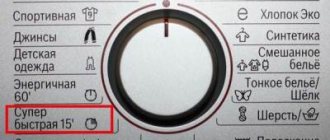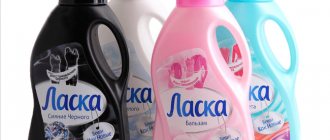Specifics of denim
This fabric has several established synonymous names: jeans, denim and others, more slang. All of them are used when it is necessary to note its strength, durability and unpretentiousness in everyday use.
Denim clothing is durable and easy to care for.
However, despite its "indestructible" image, denim is quite finicky when it comes to washing or cleaning. It does not tolerate friction, strong bends or breaks, and is also extremely sensitive to various bleaches (color).
Errors in care can lead to the product losing its shape, changing color, or causing local deformations. Therefore, most recommendations on how to wash jeans come down to strict adherence to care instructions. This is especially true for removing stains.
If not properly cared for, jeans may lose their shape.
It is known that it is better to treat jeans with cold water. Since they are made from cotton, the original structure of the fabric fibers can change significantly when certain negative conditions occur. These can be considered high temperature and violation of the drying regime.
High temperatures can damage fabric fibers.
Problems with lightning
© Rath/Getty Images
- If suddenly the zipper on your jeans suddenly stops working, then a graphite pencil can come to your rescue, which you need to draw along the entire length of the zipper. If suddenly the pencil was unable to cope with this problem, then you can move on to other lubricants, which could be soap, a drop of oil or hygienic lipstick.
- If the lock on your trousers does not stay on top and is not fastened all the way, then a saving solution for some time can be a ring from your key ring, which can be attached to the zipper slider, and then hooked to the top button. This way, your trousers will no longer unbutton on their own when not needed.
- If some teeth are missing on the zipper of your trousers, you are unlikely to be able to fasten your jeans properly. In this case, the zipper should be replaced with a new one. But in some situations, if there is no tooth at the very end of the zipper, you can do without replacement. The slider should be fastened so that it is slightly higher than the damage site. Now you can make a few stitches with a needle and thread above the place where the tooth is missing.
- You can also carefully remove the damaged lock and make a clasp that will fasten with buttons.
- If at the most inopportune moment the slider on the lock of your jeans comes off, without which it will be almost impossible or very problematic to fasten them, then as some kind of temporary solution you can attach a paper clip or a ring from a key ring instead.
Required washing frequency
Most experts recommend washing your jeans as little as possible. At first glance, this sounds shocking, however, there is some truth in this statement. Of course, it all depends on how you wear them, but in many cases the optimal interval between washes is once a quarter or once every six months. This is determined by the degree of contamination and frequency of wear.
The frequency of washing mainly depends on the degree of soiling of the jeans.
Why is that? The fact is that a significant amount of dirt and stains is removed locally, and in order to refresh the fabric and put it in order, you can do without a washing machine with its jeans washing mode. So, the established smell can be removed by placing the pants in the freezer of the home refrigerator (of course, it is better in a bag or fabric bag).
Sometimes local spot cleaning is enough.
To even out creases and refresh the color, just hang them in the bathroom, next to you, while taking a shower. Moisture and steam will serve as a softener, so that after drying, the pants can be safely worn for quite a long time.
Note! It is advisable to wash your jeans for the first time immediately after purchase. You can first soak them briefly in warm water. This is done in order to remove excess paint from the product - especially important for black and indigo pants.
Dark trousers can be washed immediately after purchase to get rid of excess dye.
What detergent to use
The use of regular powder for washing jeans is prohibited, especially with bleach. The fact is that powder granules plant fibers, are poorly washed out and destroy the material. There may also be whitish streaks left. The only way out is to use gel-like products or laundry bar soap.
There are special soft gels for denim on sale. Branded brands often offer their own cleaning products. Thus, the Japanese company Momotaro Jeans offers the composition SZ-001 Jeans Detergent with palm oil extract. This is very economical and aesthetically pleasing, since no more than 30 ml is required, and the item will acquire a delicate peach aroma, which laundry soap cannot boast of. The product itself will look no worse in the second year of wear than on the day of purchase.
Samurai Jeans offers Kaminari Soap. It includes 3 components: water, soybean oil and caustic soda. They hold the color reliably, and the product looks like new even after years of wear.
The packaging of any product contains dosage information. This advice should not be neglected, since this indicator is individual. An overdose leads to poor rinsing and retention of detergent particles in the fabric, and an insufficient amount of the composition does not wash the item.
Before washing jeans: preparation
First of all, you need to carefully read the information on the label, which is sewn on the reverse side. Typically, manufacturers indicate which washing modes are allowed and what is allowed (or prohibited) in this case.
Before proceeding, you need to take into account the information on the label.
First of all, you need to clear your pockets of debris, turn your jeans inside out and fasten the zipper or buttons. Women's models, replete with frills and trinkets, must additionally be placed in a special bag, preferably canvas, but a mesh bag is also possible.
The zipper on the trousers must be fastened.
If there are planted spots, it is advisable to pre-treat them with a stain remover (or other suitable product) and wait a little. Next, everything depends on the selected washing mode.
Need for ironing
© amete/Getty Images
There is absolutely no need to iron jeans after washing. They straighten out quite calmly on the human body, if only they were dried completely straightened out.
If the jeans still require ironing, then you need to turn the item inside out, slightly dampening the fabric. The iron should be turned on to the lowest heating setting.
And it’s best to use a steamer for this purpose, which can easily rid your trousers of all kinds of creases.
How to do this correctly?
There is no universal recipe for caring for jeans, but in most cases, general tips and recommendations include:
- Read the instructions on the attached tag.
- Surface preliminary mechanical cleaning.
- Before washing trousers in an automatic washing machine, you should make sure that there is a special mode and strictly adhere to the manufacturer’s instructions.
- Wash only in cold or slightly warm water.
- If possible, it is better to use so-called dry cleaning.
- It is prohibited to wring out jeans.
- Follow the drying rules: do not overexpose and place correctly on the clothesline.
When washing your jeans, you must follow the instructions.
Additional Information! Washing should be done as little as possible. If there are no clearly visible dirt or stains, a sign that it is time to send the pants to the machine may be the appearance of sagging in the back or abrasions under the knees.
It is not recommended to wash denim too often.
Washing mode for jeans in a washing machine
First of all, you need to remember two rules: temperature and mode. Denim fabric is greatly deformed when exposed to high temperatures, as well as in case of excessive mechanical stress.
The most important thing is to observe the temperature regime.
Therefore, in order not to spoil expensive trousers, you should strictly adhere to the following recommendations:
- Wash jeans only inside out.
- If possible, do not use powder. There are special gels for this. In principle, a regular universal gel will do.
- Select the desired mode. Modern machines often have a special program for washing jeans. Otherwise, you will need to turn on the delicate wash option.
- Try not to use the spin cycle. If such a function is missing, set the minimum permissible speed.
- You can add conditioner.
- Do not use automatic drying!
To wash jeans in a machine, you need to follow some rules.
How to wash jeans by hand?
This is the most optimal way of care. However, it may not be entirely convenient, since washing such pants does not involve them being wrinkled or twisted. Jeans should be washed at their full length. This may require a bathtub or large trough. The water should be either at room temperature or heated, to a maximum of 30-35 degrees.
It is best to wash jeans by hand.
In case of extensive contamination, short-term soaking is allowed (an hour to an hour and a half). In this case, to enhance the effect, you can add a glass of ordinary vinegar and a couple of tablespoons of sugar to the water. During washing, it is strictly forbidden to wrinkle the fabric or rub parts of clothing together. To do this, it is advisable to use a brush with medium-hard bristles.
In this case, the treatment should resemble the mode of washing jeans in a washing machine - you need to carefully run the brush along the fabric, without squeezing it or twisting it.
Sometimes pants can be soaked for a short time.
It is best to use regular laundry soap or gel. If you have to wash with powder, you must first dilute it, otherwise streaks may remain, even with good rinsing. Dry washed jeans on a clothesline. If the clothes have shrunk a little, you can stretch them slightly, but only while they are damp!
It is preferable to use laundry soap or gel.
Washing black jeans
Equally important is the issue of properly washing new jeans, and many are especially interested in how to wash black jeans.
- To properly wash black or new jeans with a bright color, so that they do not fade, you can first soak them briefly in water with vinegar added to it. The acid in vinegar helps lock the color into the denim fibers.
- The first wash should be done separately, and not with other things, so as not to spoil them. But if you purchased jeans from a well-known brand whose quality is beyond doubt, there is no danger that they will fade after washing.
- As a general tip, we can add: if you want jeans in black or other bright colors to not fade when worn and not cover your legs with black or blue spots, you need to reduce the temperature setting of the washing machine.
If your black jeans have lost their original color over time, it is recommended to use the following advice.
To disguise color fading on black jeans, dissolve a tablespoon of fabric dye in a bucket of cold water. Dip your jeans in it for a while and dry without rinsing.
After drying, you can wash off the dye. Often after this procedure, jeans look like new.
Denim clothing: detergents
All denim care products can be divided into two types: stain removers and special additives. Typically, stain treatment can be carried out both at the preliminary stage before washing, and immediately after contamination. The latter case includes all kinds of wipes and sprays.
More effective products are available in the form of gels or powders and are applied to the affected areas already at the soaking stage.
The gel is applied during the soaking stage.
Therefore, before washing jeans in a washing machine, it is advisable to worry in advance and purchase a special washing gel for this particular type of fabric. As a rule, it is environmentally friendly because it contains natural ingredients.
The features of such care products include:
- Preservation of color (things do not fade).
- Effectively removes most contaminants.
- Softening the fabric and saturating it with aroma.
- Contains no bleaches or third-party aggressive substances.
Special tools have their advantages.
Domal Jeans and Synergetic
It’s better to give up the usual powder and look for a new detergent among its liquid counterparts. The modern market offers many well-known brands of varying prices and volumes. Among the denim leaders are Domal Jeans and Synergetic.
Introduces a special detergent for washing denim fabrics Synergetic. This is a domestic manufacturer of household chemicals, specializing in the production of safe and biodegradable products. The mentioned gel contains only natural and hypoallergenic components: water, plant A- and H-tensides, green chelate, functional additives and perfume composition . The cost varies between 200-320 rubles per 750 ml. The liquid is suitable for machine and hand washing. Moreover, the concentrate not only carefully and effectively cleans denim, maintaining its brightness, but also prevents dust and dirt from re-depositing on the fibers.
Domal Jeans Fashion washing liquid from Germany is also a universal concentrate, but with a more active composition. Thanks to the interaction of surfactants, nonionic surfactants and enzymes, the product is able to remove even old stains from dense fabric. Despite the “aggression”, the decor on the jeans, appliqués, accessories, embroidery and rhinestones do not suffer at all. The gel is sold in 750 ml bottles for 350-400 rubles.
How to wash jeans to remove stains?
Most stains can be removed using special chemicals, as well as using so-called folk remedies. Typically, stains are treated either before washing or without washing at all. Below are the most common types of contaminants and popular methods for removing them:
- Coffee, grass, ink. Removed with a solution of regular dishwashing detergent and water. You need to moisten a clean white cloth in it and gently wipe the stain, moving from the periphery to the center. If the dirt is ingrained, it is necessary to treat the inside as well.
- Typical contaminants: dust, grease. Such stains can be removed quite well with regular salt. To do this, apply a thin layer of table salt to the stained area, then blot it with a clean cloth soaked in detergent.
- Wine. The best way to remove wine stains is with hydrogen peroxide. In some cases, you can “salt” the stain before treatment.
Various tricks
By following certain rules for caring for good jeans, you can actually wear them for more than one or even two years. Interesting fact: this material in trousers can adapt to even small changes in a person’s figure. This applies primarily to the fact that the changes will not be too significant.
If the owner of the jeans has lost weight, but the pants themselves have stretched, then this situation can be saved as follows:
1. You can wash this item directly on yourself. To do this, you need to sit in your jeans in a bathtub with not very hot water, lather a sponge or your own hand with any soap and gently rub the fabric with it. After this, without removing the item from yourself, you must also rinse it on yourself with clean water. Now let the jeans dry again directly on the body.
This method is appropriate only when the ambient temperature is quite high, that is, in the hot season, since at lower temperatures the item will dry out for a very long time.
Jeans washed this way will fit your figure just perfectly.
via GIPHY
2. You can speed up the drying of jeans using a special mode available in the washing machine. You can also reduce the size of various individual elements, for example, elongated places on the knees, or the entire thing.
There is also a solution if your jeans become too small for you:
To do this, you need to lightly moisten them with a spray bottle or simply sprinkle them with water and then put them on yourself. Wait until the jeans dry on you, and you will notice that they themselves stretch out in the places that you need.
It doesn’t matter if you have gained a lot of weight and the moment comes when you are unable to button up your favorite trousers. In this case, it is also recommended to wet only the belt and the waist area of the trousers with water and stretch this area as much as possible with the help of books inserted between the fabric and your body.
3. Are you a conservative and always buy the same model every year, but it suddenly suddenly disappeared from sale? No problem! Don’t despair too much, you can still continue to buy it the same way you used to do it before. Pay attention to the label located on the inside of the trousers. On it, if it has not been erased, of course, as a rule, there is information and all the data specifically about your trouser model. You can simply find them on the Internet and purchase them again.
White jeans!
This type of clothing is especially sensitive to various stains and careless wear. Therefore, the issue of proper care for white denim trousers is very relevant. In principle, the whole difference comes down to the specifics of stain removal. Otherwise, you should follow the general recommendations regarding how to wash jeans.
White clothes are more likely to get dirty.
Most importantly, when cleaning, you should only use a white cloth to avoid leaving any possible streaks. In this case, the affected area must be treated by blotting, but not with rubbing movements. Even though the jeans are white, you should be very careful when using bleach as the fabric may turn yellow.
Also, the yellowing effect often appears when drying at high temperatures. In this case, the pants are hung out in the sun. Now, on the contrary, it will be for the good.
White jeans may turn yellow when washed, so you need to be careful with bleach.
Storage
Learning how to wash your pants correctly is only half the battle. You also need to learn how to store them correctly. Most people make the same mistake over and over again: folding items and storing them in a stack.
We forget that in this way the fabric in the folds will wear out faster. In fact, jeans deserve the same careful treatment as trousers with creases. If you want to store your trousers correctly, they should be hung in the closet on hangers with clothespins.
How to wash jeans: common mistakes
The most common mistakes when washing denim products are failure to comply with the temperature and drying conditions. Therefore, in order to ensure the proper appearance of the washed product, you should remember that it is strictly not recommended:
- Use hot water. At temperatures above 40 degrees, the fabric begins to shed intensively and “shrink.”
- Use bleach. Almost always this only leads to a worsening of the situation (the exception is white jeans).
- Use washing powders. The presence of phosphates in their composition leads to faster fading. This is especially noticeable on black and indigo products.
- Squeeze. It is best if the moisture leaves the fabric naturally by evaporating. Squeezing in a machine or squeezing out water by hand often leads to loss of shape.
If you do not follow certain rules, the item may become damaged after washing.
Caring for your favorite clothes
© Rogerio Martins/Pexels
If you choose the right type of jeans, they will highlight your figure and also hide some of its flaws. Plus, they will also easily approach a variety of things. Finding such trousers is not always easy the first time, but if you succeed, then you will, as a rule, wear them for many years, practically without taking them off.
- Always buy jeans half a size smaller than necessary, or even a whole size. Ideal jeans should be difficult to fasten after purchase when you first put them on, but literally after a few days they stretch, hugging your figure. But don’t overdo it, because jeans that are too tight can interfere with your blood circulation and can also cause swelling or some other illness in your body.
- Wash your pants as often as possible.
- If you notice that a shine has begun to appear on your jeans, then you need to moisten them with a weak solution of ammonia, then apply washing powder, and only after that you can proceed directly to washing.
After washing: how to dry correctly?
Even after setting the required mode for washing jeans in a washing machine, or soaking them in the bathroom according to all the rules, the result may still be unsatisfactory. The fact is that washing is only one of the stages in caring for denim fabric. It is also important under what conditions clothes are dried.
You also need to dry your jeans correctly.
First of all, the fabric should not be kinked or wrinkled. If it is not possible to hang your jeans by the waist or bottom, it is recommended to place a towel roll under the leg. In addition, you should not hang denim items in the sun. Direct sunlight is a sure way to ruin the original color.
Do not hang denim clothes in the sun.
In some cases, it is advisable to iron your pants to give them a more well-groomed appearance. This should be done when they are still slightly damp. Moreover, you can iron it from the front side.
You need to iron your jeans while they are still damp.
Understanding the rules for caring for denim products is not only the key to their durability. Among people, such a characteristic feature as attachment to material objects is often observed. Therefore, knowing how to wash jeans and properly care for them will allow you to wear comfortable and familiar clothes for a long time, which will make you feel more at ease, regardless of the situation.
Can jeans be washed with other items?
Sorting things depends on the material from which they are made and color. If you need to put light-colored items into the drum, then you can only put white jeans with them. With dark clothes you can wash all other colors.
But this does not apply to the first wash after purchasing a new thing. After all, every second denim item can fade during its debut wash. This is due to the fact that the jeans are coated with a natural indigo dye.
Another simple but important rule that everyone often forgets: clean thick denim only with fabrics of a similar texture. Otherwise, delicate silk or chiffon will be damaged. T-shirts and tank tops can be safely sent for washing in tandem with jeans, if the former are made of cotton and are similar in color to the denim product.
Dark items can be mixed with denim, but if you have doubts about a particular item, it’s better not to risk it and rinse it separately.
Preparing for washing
Before loading into the washing machine, items undergo primary preparation, which most often consists of soaking and bleaching. It is strictly forbidden to bleach dark and colored jeans, unless we are talking about creating a fashionable “varenka” effect. Aggressive microelements of such products quickly eat away the color, so only white models are suitable for such manipulations.
With soaking, the situation is simpler - it is recommended to completely immerse the jeans in the soap solution so that after treating the local area there is no faded stain left.
To properly wash jeans, you need to follow these rules:
- carefully study the label and follow all the symbols indicated on it;
- Wash jeans by turning them inside out and fastening all zippers;
- remove foreign objects from pockets that can damage not only the fabric, but also the car;
- use special liquid products, avoid the use of microgranules and substances containing chlorine and other bleaches;
- Pre-treat leather elements with glycerin to prevent creases and cracks from forming on them.
Washing mode
Manufacturers indicate the recommended washing mode on the labels of their products. As the area to be decorated increases, the degrees and speeds should be reduced in order to leave all metal and plastic fittings intact. It is better not to overdo it with long soaking.
Soaking in a machine can cause rust on buttons and other metal parts. If such an oversight is forgivable for dark fabric, then white trousers or a jacket will be completely ruined. Also, the quality of modern clothing varies greatly, and in addition to loss of color, many things are shrinking. Some machines have a special program for processing these things. In this case, you need to select it. If the fabric is less dense, the delicate/manual mode is set.
Washing temperature
The optimal degrees for each product are individual and are also indicated on the tag. If for some reason this information is not available, it is worth remembering that the optimal temperature is 30-40 C°. The standard mark for washing thick denim is 40 C°.
A higher degree can ruin the shape of the item and lead to shrinkage or stretching, especially if the composition contains a large percentage of synthetics. High speeds are dangerous for safety and in places of creases, intense friction will lead to washing out of the dye. Therefore, set the number of revolutions to a minimum (400-600).
It’s nice to take an almost dry item out of the drum, but if this threatens the integrity of the clothes, it’s better to set the spin cycle to minimum or turn it off completely. After removal from the drum, there is also no need to unscrew it by hand. If there is excess moisture, it is better to hang the item in a vertical position so that the water drains naturally.
Drying things
You should approach the drying stage responsibly and know the general recommendations for drying denim items:
- To prevent the product from “hardening” after washing and the fabric from becoming tougher, add a softening conditioner;
- if clothes dry in direct sunlight, they will become stiffer and cause discomfort on the first day of wear;
- do not place in the dryer;
- excessive drying threatens fading and shrinkage;
- dry jeans with the wrong side up;
- place the jeans vertically on the rope;
- smooth along the seams so that there are no creases left on the fabric;
- To avoid wrinkles, fold the trousers at knee level and dry in this position.
If your jeans do become sagging, don’t be upset. They will adjust to size during use in a fairly short time. It is better to remove a slightly damp product from the rope, drying the fabric with an iron.
So, washing jeans in a washing machine is not prohibited, but experts recommend doing this only if necessary. If possible, do not neglect hand washing. It is worth understanding that any thing changes its appearance over time, and in order to prevent this from happening for as long as possible, it is important to adhere to simple rules for processing denim clothing.
Soaking: benefit or harm?
Not every laundry can be soaked, and not everyone needs it, but in some cases it significantly improves the efficiency of washing. For example, it is always recommended to soak greasy kitchen towels before washing. Fill them with a bucket of warm water (forty degrees) and add one tablespoon of vinegar. This solution helps break down fat and will help restore kitchen towels to their former freshness. To bleach laundry that has begun to turn yellow, soak it in a solution of boric acid at a rate of 1-2 tablespoons per 10 liters of water.
Soaking laundry is recommended not only to remove heavy soiling, but also to soften rough fabric. Thus, cotton that has become hard becomes pleasant to the touch if you soak it in water with the addition of ammonia before washing (1 liter of water - 1 tablespoon of alcohol).
You should not soak woolen items (this causes animal fibers to lose strength and even break down), you should not mix black and white fabrics when soaking, and you should also be careful with high-temperature water. However, it is not for nothing that our grandmothers and mothers loved boiling as a method of bleaching and removing stains. And it makes sense to adopt this experience.
How and why to boil laundry?
Boiling laundry will help restore its whiteness, and softness and fluffiness to rough terry robes. To boil laundry, you need to put it in an iron bucket or other container, fill it with water and washing powder or other detergent. Difficult to remove stains are first rubbed with soap. You need to boil the laundry for half an hour to an hour, stirring occasionally, so that the fabric is constantly in the water and does not float on the surface. To make terry products soft, they need to be boiled in salted water or kept in such a solution after washing. It is extremely undesirable to boil colored items and completely unacceptable to boil woolen, silk and those that contain lycra.











